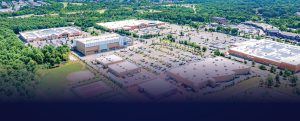
A New Beginning
As businesses were forced to navigate a new type of economic downturn in 2020, profound changes unfolded and have reinvigorated the quick-service and fast-casual industry. In particular, the industry pivoted to more off-premise channels, digital tools, and enhanced efficiency. Downturns of any kind tend to birth new trends but also accelerate changes already underway. After all, many well-known restaurant brands were investing in people and tools pre-COVID-19 to ensure infrastructure was ready for the future – many just assumed it was still a couple of years out from fruition. From this viewpoint, knowing the market is heading down this path at an accelerated pace has allowed brands to design restaurants and kitchens for the future. In this article, Matthews™ explores industry-leading, multi-national companies and their strategies to service the new age of diners.
Rebranding the Industry
Customers are experiencing restaurants through digital platforms now, more than ever. Many of them only just began using these platforms during the pandemic as a means to order food directly to their home or car, bringing a whole new customer base into the digital fold. Adapting to the digital space in 2020 wasn’t just a matter of innovation; it was a means of survival for the industry. Quick-service restaurants were specially prepared to take on the havoc invoked by COVID-19. They were already working with delivery aggregators, partially relied on drive-thrus and curbside pick-up, and pivoted early on in the pandemic to new solutions. Technologies like mobile ordering, high-tech drive-thrus, double lane drive-thrus, and curbside pick-up were once just blueprints for future consumer behavior but have become a cornerstone for how quick-service restaurants, and more recently, fast-casual brands, remained successful in 2020.
Years of Innovation, Compressed Into Months
The move toward drive-thrus and other off-premise models is a trend seen across the industry. In addition to traditional drive-thru customers, the pandemic-enhanced shift of diners to off-premise channels also brought an increasing presence of delivery drivers and curbside pick-up traditions. However, as brands serve more customers through drive-thrus, curbside, or pick-up, the increased volume translated to improving the speed of service and managing more orders than usual. To efficiently manage the increasing demands while simultaneously improving the guest experience, many brands have relied on technology to communicate with customers and team members to minimize drive-thru time and increase turnover. It is a straightforward notion that there’s a correlation between faster service and serving more guests. More recently, quick-service restaurants have been searching to enhance the drive-thru experience in ways that truly feel futuristic, like tracking license plates to create customer profiles or using artificial intelligence to predict what people want to order. McDonald’s, the leader in quick-service restaurants, is even testing automated voice ordering, stating that the system can handle 80 percent of order volume.
The two critical issues of a drive-thru are speed of service and order accuracy, which are often correlated. COVID-19 bolstered these issues but put into focus that drive-thrus carry considerable potential, and these technologies are on track to become the future of ordering. The demand for drive-thrus was already accelerating pre-COVID-19, with many tenants completing significantly higher volumes in locations that offered drive-thrus compared to ones that did not. Before COVID-19, dine-in was generally 70% of sales, and drive-thru sales were the remaining 30%. Now, those percentages have flipped as drive-thrus see a 25% to 35% increase in sales. In October 2020 alone, drive-thru sales increased 24%, according to NPD Group Inc.
Given these fundamentals, properties with drive-thrus have surged in demand. Investors, developers, and tenants are all searching for properties with drive-thru capabilities. Some developers are even searching for end-caps or sites with enough space to downsize store footprints and create stand-alone drive-thru restaurants, or side-by-side drive-thru lanes, which add to the overall footprint and unlock more potential. As drive-thrus are labeled pandemic-proof, demand has increased, and over the past 12 months, more drive-thru deals have occurred than the previous three years. For example, Dutch Bros. locations are all under 1,000 square feet, with either one or two drive-thru lanes, and relied on this business model throughout the pandemic. However, adding drive-thru capabilities to land is not always easy. For example, drive-thrus need multiple entrances and exits, enough room for a line of cars, and city approval. Before the pandemic, many cities had moratoriums on drive-thrus for reasons that include drive-thru-related traffic, environmental concerns with idling cars, and fast food contributing to obesity. But, COVID-19 put pressure on cities to approve drive-thrus, and there is no shortage of desire.
Comparing Strategies
Certain brands are committed to the future and will compete in the digital transformation – one of which is Starbucks, that many operators turn to as a leading example. The other is Chipotle, which has a primary goal of expanding access and convenience through a digital ecosystem, adding 700 new-construction drive-thru restaurants by 2025.
STARBUCKS
Starbucks created a world-class drive-thru operation and emerged as an innovator in the technology space. For a company that has been praised virtually since its inception, this may come as no surprise. The story of the company’s rise to industry leadership is based on its commitment to developing solutions based on customer needs and behaviors.
Despite announcing the closure of 800 stores, Starbucks says it will have 55,000 locations by 2030 as it continues to develop experiences that address evolving consumer routines. This unit level is unmatched by any other company in today’s restaurant world. Currently, Starbucks boasts some 33,000 company-operated and licensed stores across more than 80 markets worldwide.
The brand was already expanding ahead of COVID-19, and the 800-unit cut will accelerate its plans to relocate low-performing stores and transform the store format. According to QSR Magazine, Starbucks originally had a broad, three to five-year plan to move units – such as those in low-traffic malls – to higher-performing locations which can utilize drive-thru services. That timetable has been moved up to the next 12 to 18 months.
Early on, Starbucks found their locations through developers employing brokers to call franchise-operated restaurants with drive-thrus, buying them out of their lease, and forming a joint venture with an existing landlord or purchasing directly from that landlord. This is a strategy Starbucks continues to implement as well as other fast-casual brands seeking drive-thru space.
Convenience + Accessibility = Loyalty & Reach
During the pandemic, factoring in working-from-home and the demolition of day-to-day routine, Starbucks pivoted from a “first stop on the way to a destination” to a “destination worth leaving home for.” In this shift, the average ticket size increased 20 percent in the U.S., although consumers were ordering less often.
Starbucks aims to expand its digital reach through new storefronts, which enable curbside pick-up, further delivery, and critically increase throughput in the drive-thru. These stores will have no seating, smaller square footage from 400 to 1,700 square feet, and side-by-side drive-thru lanes. Starbucks’ transformation will also include renovating layouts to add separate counters for mobile orders at high-volume stores, which enable customers and delivery couriers to grab-and-go without the bottleneck.
Pick-up venues, which Starbucks said will number in the “hundreds” in five years, plans to drop in trade areas as additional accessibility points. The company pictures traditional cafes, complete with the “third-place” promise, supported by a pick-up store within walking distance that can reduce crowds and provide a more convenient format for those guests who don’t want to grab a seat.
The company will also extend drive-thru development into suburban and semi-rural locations, extending the reach of the Starbucks brand, providing customers with the convenience they are seeking. Moving forward, 45 percent of stores will offer drive-thrus, compared to the current level of 35 percent.
CHIPOTLE
As dining rooms shuttered and occasions shifted to off-premise, Chipotle’s digital sales skyrocketed to $2.8 billion in 2020, a 174 percent boost versus the prior year. Further, the brand entered 2020 with fewer than ten million reward members. Today, there are nearly 20 million, and roughly 60 percent are active. Put more broadly, Chipotle is now more relevant than it was in the past, thanks to the digital transformation caused by COVID-19.
Chipotle’s strong digital system has helped set the brand apart from its rivals, and the future of the fast-casual restaurant depends on its success of the drive-thru, otherwise called “Chipotlanes.” The familiar fast-food format hasn’t been a requisite for fast-casual formulas and is relatively new for Chipotle. With more than 120 “Chipotlanes” in the restaurant fleet (total 2,710), Chipotle said they have helped with profitability, although they work slightly different from the conventional version. Rather than pulling up to a menu board and projecting ingredients at an intercom, customers must place the order online first. The key to the models’ power is it gives diners an incentive to download Chipotle’s app and join its loyalty program, which further enhances the digital ecosystem, meaning more data. Additionally, customers can move through the drive-thru lanes relatively quickly, given they are just picking up their order. This has helped with customer satisfaction and allowed the pick-up window to serve more customers.
The fast-casual restaurant intends for more than 70 percent of its new store openings in 2021 to have drive-thru lanes and also plans to remodel or relocate ten to 15 restaurants so it can add “Chipotlanes.” In locations where a drive-thru is impossible, the company will instead have a walk-up window. As investors are aware, cap rates are the definition of supply and demand. With 700 new construction Chipotle’s with drive-thrus, one can argue that the cap rates of non-drive-thru-equipped sites will increase 100 to 200 basis points from where they are trading today in Q3 2021.
As the company adapts to consumer shifts in demand, Chipotle plans to explore self-driving delivery cars with their investment in Nuro, a robotics tech provider. And a new store prototype dubbed “Chipotle Digital Kitchen” requires the customer to order in advance via its app, website, or third-party delivery. Food is then picked up in a lobby designated to mirror a traditional Chipotle.
Taking A Page from Starbucks’ Playbook
With Chipotle undergoing a massive transition to “Chipotlanes,” it is currently following a similar trajectory to Starbucks. Although Starbucks is two to three years ahead of Chipotle, Chipotle investors and landlords can learn from Starbucks’ operational strategy. Chipotle aims to open 200 new locations annually through 2025, with 70 percent of them containing a drive-thru. Therefore, Chipotle is actively seeking new sites. With the support of developers and tenant representation, brokers are buying existing quick-service franchisee restaurant operators (Burger King, Bojangles, KFC, Pizza Hut, etc.) out from their franchise lease agreements with their respective parent company and signing a new Chipotle lease with the existing landlord of the drive-thru-equipped property. This strategy is a win-win scenario for the landlord, Chipotle, the prior franchisee operator, and the developer.
Short Order? Not so Much
In response to the evolving ways in which consumers are engaging with restaurants, many top limited-service brands have announced new store prototypes – many of which come with stark changes. There is heightened demand for digital technology, drive-thru operations, and curbside pick-up ease, as consumers expect more customization, convenience, and accessibility. For quick-service and fast-casual restaurants, the future is nothing short of exciting, as businesses have enhanced operational plans for efficiency thanks to COVID-19.
10 Questions for Landlords
- How is my tenant performing?
- What is my tenant’s new prototype design?
- What is the average gross sale revenue, or EBITDA, increase for the said prototype?
- When and how is the new format being implemented?
- What is the cost per square foot and physical property requirements (lot size, building square footage, drive-thru lanes, etc.)?
- Is it cheaper for my tenant to relocate and construct a new building from scratch?
- What other tenants could operate my building if the current lessee vacates the site?
- On average, what does my tenant pay in annual rent to operate new locations?
- How does my current rent compare, locally and nationally?
- Why would my tenant stay or vacate the premises?
For more information, please contact a Matthews™ specialized agent.









